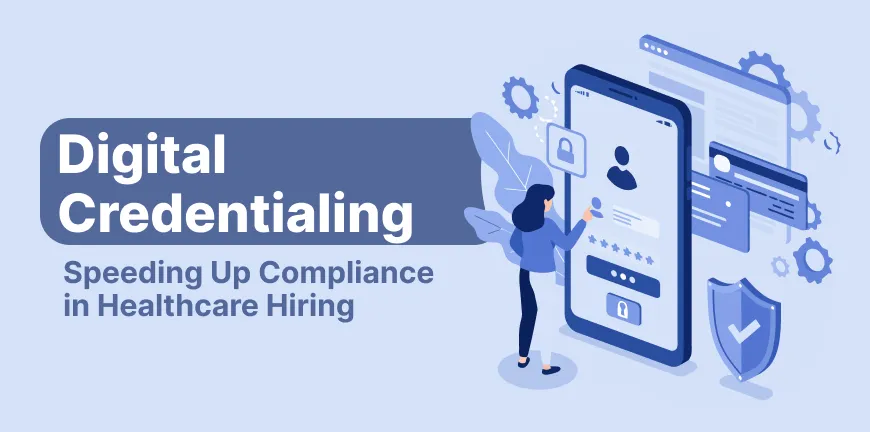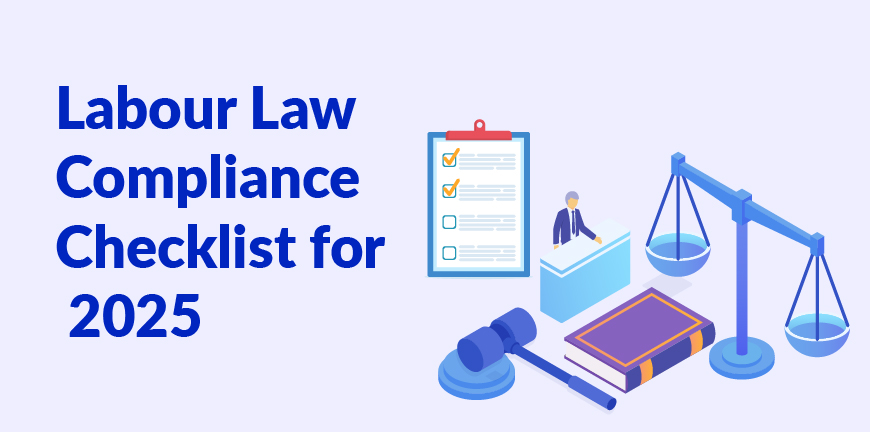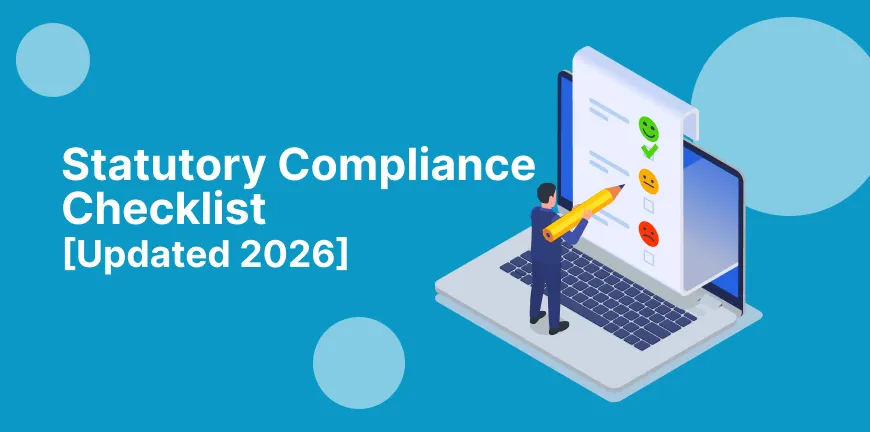
What is Human Resource Development (HRD)? 2025 Complete Guide
13/10/2025
What is Internal Recruitment? Definition, Types, Advantages, Process
13/10/2025- Defining Digital Credentialing
- Major drivers pushing healthcare toward digital credentialing
- Digital Credentialing Expediting Compliance in Hiring
- Real World Examples
- Challenges & Risks in Digital Credentialing
- Best Practices for Implementing Digital Credentialing in Healthcare Hiring
- Potential Impact on Organizations
- Trends Shaping Healthcare Digital Credentialing
- Key Data & Figures
- Relevant Data & Indicators in India
According to the Grand View Research Report, Credentialing software & services are projected to reach USD 1.42 billion by 2030.
Healthcare hiring can get complicated with its unique ecosystem, where credentialing is a significant tool. Today, it is not just about standard record checks. It is about healthcare firms ensuring that every member of their team must possess a valid certification, license, be properly vaccinated, etc. Manual credentialing, a popular process historically, has been a constraint in healthcare recruitment.
Digital credentialing has made an entry into the space as a transformative force with its innovative technologies automating, securing, and expediting the entire procedure of managing credentials.
You want to dig deep? Let us explore the advantages of digital credentialing in the healthcare sector, its challenges, technologies used, etc.
Defining Digital Credentialing
Digital credentialing in health care is a system in which automation and digital tools are used to manage and verify credentialing processes that entail qualification checks. Licence verifications and capabilities of healthcare providers. Credentials like digital certificates and validation documents are handled in cloud-based systems.
Major drivers pushing healthcare toward digital credentialing
1. Mandatory compliance standards and Regulations
Healthcare regulatory bodies across the world today have imposed stringent rules on aspects like licensing, practice scope, sanctions, assessments, etc. There is a risk of hefty penalties, legal obligations, and accreditation loss if the rules are not complied with. Organizations must adhere to rules, regularly track, and verify credentials.
2. Operational bottlenecks and Cost increase
Old methods of credentialing are time-consuming, leading to delays in the work of healthcare professionals who have just set foot in the industry. This can result in delayed revenue generation for companies and likely staff scarcity.
Error Prevention and Risk Control
Human error is a common problem when it comes to manual data entry. There can be incomplete and misplaced records with traditional credentialing methods. Another critical aspect is that the failure to regularly monitor sanction lists, invalid licences, and other actions might expose firms to legal hazards, penalties, etc.
Workforce Retention and Support
Healthcare professionals are usually worried about the credentialing and onboarding processes, as they are lengthy and complex, especially when providers are working across employers and various locations. A systematic and digital process encourages the staff to stay in organizations for a longer time and enhances staff experiences.
3. Scalable Manpower Planning
With the advent of telehealth systems, an increase in contingent healthcare providers and staff working across regions and states, the historical credentialing systems are becoming obsolete. To cater to the new demands, digital credentialing platforms are gaining momentum.
Digital Credentialing Expediting Compliance in Hiring
Let us have a look at the mechanisms by which digital credentialing enhances compliance and recruitment:
| Mechanism | Traditional Process | Digital-Enabled Process | Time / Error Savings & Compliance Gains |
| Document collection and submission | Documents are essentially paper forms, scanned by workers, with the possibility of delayed and incomplete arrival. | Documents are uploaded digitally by candidates, and embedded systems ensure that they will be complete.
|
The number of missing documents is less, and swifter submission, etc. |
| Primary Source Verification (PSV) | Manual calls are made and emails written to licensing boards, institutions, resulting in waiting for mail and manual responses. | APIs or digital integrations with boards/registries; automated checks; sometimes real-time status | Much faster verification; less human intervention; more accuracy. |
| Identity checks & background screening | Manual verification; background checks may be delayed, require multiple steps | Digital identity verification, using secure ID checks, automated background/sanctions screening tools. | A swifter process ensures adherence to laws, reducing the risk of fraudulent credentials and costs. |
| Notification of expirations/renewals | Staff track expirations manually; risk of oversight; reactive renewals | Automated alerts when license or certificate is about to expire; scheduled renewals; dashboards for tracking compliance | Prevents lapses; ensures continuous compliance; avoids penalties or gaps in staffing |
| Secure storage & audit trails | Paper files or unorganized digital folders; risk of loss, tampering; difficult to audit | Centralized credential repository, digital vaults, sometimes blockchain; every change logged; tamper‑evidence; easy retrieval in audits |
Real World Examples
Atlas Systems / PRIME by Atlas Systems
Atlas has a provider credentialing & enrollment solution known as PRIME Provider‑Payer Connect, which handles provider credentialing using a centralized digital data platform. Health systems and provider groups needed to reduce time and overhead in the credentialing, enrolment, and contracting process.
VerityStream (CredentialStream) is a system utilized by hospitals, health systems, and medical groups for provider credentialing, privileging, enrollment, and provider data management. They aim to replace manual, paper‑based credentialing with automated workflows, centralization of provider information, and integrations for interoperability.
Challenges & Risks in Digital Credentialing
Digital credentialing influenced by modern tech is a boon for the healthcare sector, but it also brings with it a slew of challenges that companies need to mitigate., Let us see what they are:
- Data Protection and Governance
The management of sensitive and personal data and information entailing licenses, documents, IDs, etc., requires a robust protection system. If there is a breach of security, then companies will not just face huge data loss but also penalties and image damage. - Reliance on Digital Sources
Credential verification is reliant on sources that are trustworthy, accurate, and updated. It is up to the licensing board to make its data easily accessible; if there is a problem in providing data, then automation may require manual intervention. - Integration Hazards
Organizations having old and established credentialing systems or frameworks might find it difficult to integrate the modern digital credentialing systems, and integrating them might be difficult, leading to increased expenses. - Organization and Culture Change
The shift from manual to digital verifications can be a huge transformation and can disrupt the organizational setup. It is essential to provide rigorous training before a transition, familiarizing each department with the new system. A sketchily handled transition might lead to discontent. - Accuracy & Fraud Detection
Automated systems also require a sturdy framework of fraud detection. An ill-designed system might lead to the generation of fake documents, misrepresentation, etc.
Best Practices for Implementing Digital Credentialing in Healthcare Hiring
Some of the best practices that can be adopted by healthcare firms to achieve gains, set the speed, and cater to compliance are as follows:
1. Outline Criteria and Guidelines
As an organization, you must be clear about the credential types you require, along with the regulatory norms and laws that maintain set standards.
2. Opt for Robust Platforms
Organizations must choose a system that securely stores data with restricted access with extensive audit logs.
3. Enable direct Integrations with Primary Sources.
Trust is built when systems can be directly integrated with licensing boards, certificate issuers, etc, diminishing delays.
4. Enhance provider experience
Organizations must offer healthcare providers a digital platform where they can easily upload, track, and share credentials with employers across locations.
5. Offer Visibility and Transparency
A well-crafted digital system for HR, providers, and the compliance team is essential for them to easily access updated data and information.
Potential Impact on Organizations
A well-designed digital credentialing system is beneficial to companies. Let us see how:
- Onboarding time is reduced significantly- With the digital platforms penetrating organizations, the time taken to onboard staff is diminished to days, which would earlier take weeks.
- Alleviated administrative costs – Organizations and their teams spend less time on manual tasks, resulting in cutting down the additional expenses on paper, filing, follow-ups, etc.
- Reduced compliance errors- The digital systems enhance processes and offer better tracking of expirations, sanctions, and improve the ability to produce audit reports.
- Enhanced satisfaction- Healthcare providers are happy and content with the process as they can start working quickly and avoid repetitive tasks.
- Smarter resource usage-The HR and compliance teams can focus on high-performing and valuable tasks rather than following up on missing documents.
Trends Shaping Healthcare Digital Credentialing
Let us delve into the new technologies and latest trends influencing digital credentialing:
- Blockchain Technology — This technology is a digital ledger platform that stores and secures data, preventing tampering or alteration once recorded.
- Decentralised Digital Credentials — These are formats and frameworks permitting credentials to be assessed without always being dependent on authorities.
- AI for Fraud Detection — The introduction of AI and its modern tools enables automated scanning, where anomalies can be detected easily highlighting flawed credential histories.
- Constant Monitoring — Real-time monitoring is facilitated not just during the time of recruitment but also during stages of renewal, and ongoing changes.
Key Data & Figures
| Metric / Use Case | Figure | Source |
| Onboarding / credentialing time reduction | 60–80 % reduction in turnaround time | Digital verification systems report this range of improvement in credentialing workflows. |
| Faster credentialing turnaround | 55 % faster | As per Aventiq’s automation case study, |
| Automation adoption | 63 % of healthcare organizations report reduced credentialing time with automation | From “25 Stats Medical Credentialers Must Know” |
| Adoption of software vs manual | 61 % of organizations have shifted from manual credentialing to software platforms | From a market trends report, Global Growth Insights |
| Digital identity / credentialing ecosystem growth | Digital identity in healthcare market ~ USD 12.8 billion in 2024; CAGR ~14.1 % projected | From a market report covering identity + credential solutions |
Relevant Data & Indicators in India
| Metric / Trend | Value / Statistic | Suggestions for Credentialing |
| India Digital Health Market Size (2024) | USD ~ $14.3–14.5 billion | Big investment in digital health indicates the government and private sector are spending on health IT, which can include credentialing tools. |
| Projected Market Growth (Digital Health) | Grow from ~USD 14.5 billion in 2024 to USD 52,106 billion by 2030‑33 depending on the source; CAGRs of ~20‑25% | Rapid expansion: opportunities and incentives to automate processes, including provider verification. |
| Regulatory / Legal Pressure | New regulations like India’s DPDP Act, 2023 (Digital Personal Data Protection), require secure processing of patient data and stronger standards for records, access, consent, etc. | Ensures that any credentialing/digital credential systems have to meet high compliance/security standards—motivates adoption of modern systems. |
As the healthcare landscape today evolves in leaps and bounds, with technology giving it a boost. Digital credentialing becomes instrumental and must be incorporated by healthcare enterprises as a necessity and not a luxury. The game-changing concept propels organizations to recruit faster, remain compliant, diminish expenses, and enhance patient and provider experience. It is up to you as a firm to design systems that are smart, secure, and successful.
Contact Us For Business Enquiry

Hariharan Iyer
Hariharan Iyer is the Vice President – Operations at ALP Consulting, bringing over 40+ years of experience in HR outsourcing and labour law compliance. He leads end-to-end HRO operations, ensuring process efficiency, statutory compliance, and seamless service delivery for clients across industries. With a strong background in labour law governance and workforce management, Hariharan plays a key role in driving operational excellence and compliance-led HR solutions at ALP Consulting.




